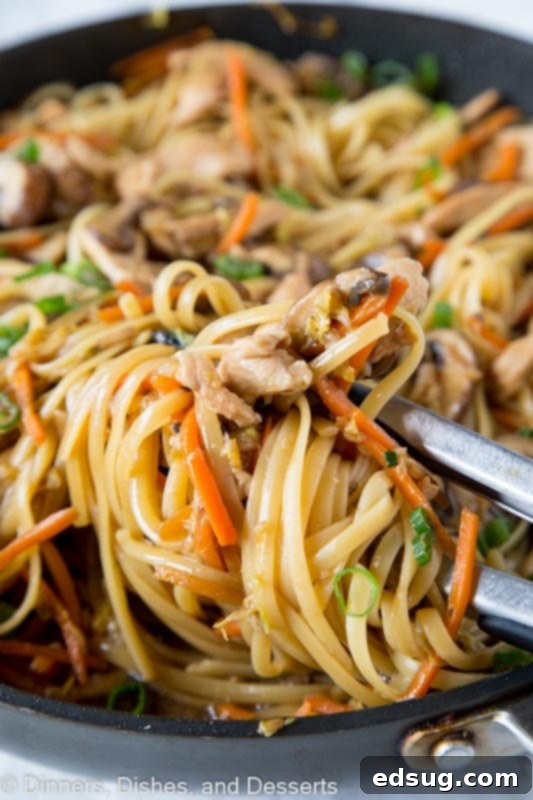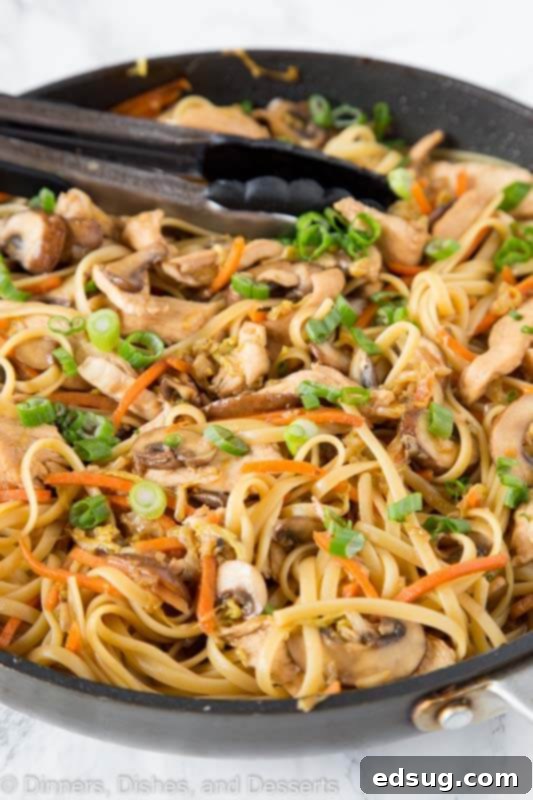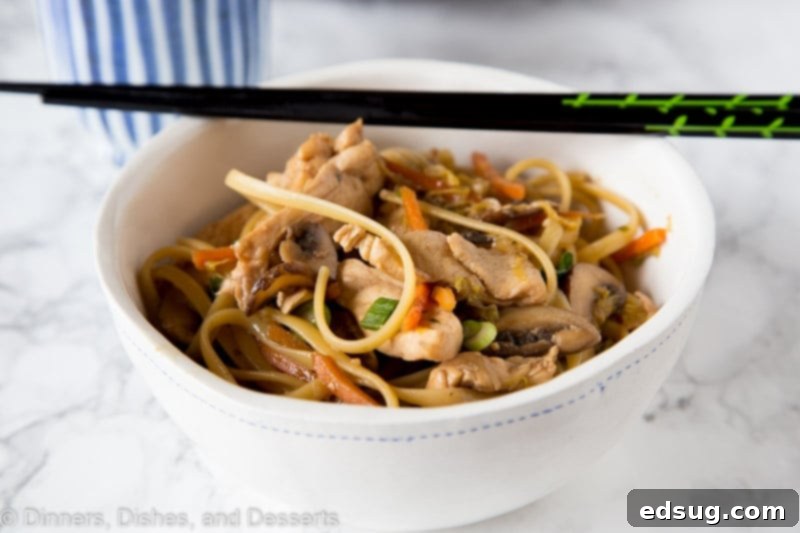Easy Homemade Chicken Lo Mein: Your Ultimate Guide to a Quick, Delicious Takeout Favorite at Home
Craving the comforting flavors of your favorite Chinese takeout but want a healthier, customizable, and even more delicious version made right in your own kitchen? Look no further than this incredible **Homemade Chicken Lo Mein recipe!** Forget greasy, expensive delivery – with tender noodles, succulent chicken, and an abundance of fresh, crisp vegetables all tossed in a rich, savory sauce, this dish is a culinary triumph that’s surprisingly simple to prepare. In just about 20 minutes, you can have a restaurant-quality meal on your table, perfect for busy weeknights or a cozy family dinner.
This isn’t just another stir-fry; it’s an experience. The beauty of crafting your own **Chicken Lo Mein** at home lies in its unparalleled freshness and the freedom to tailor it precisely to your taste. Want more broccoli? Add it! Prefer shrimp over chicken? Go for it! This versatile recipe empowers you to experiment with various proteins, a wide array of vegetables, and even different types of noodles, ensuring that every batch is a new adventure and something you’ll never get bored with. It’s an ideal way to enjoy a wholesome, flavorful meal that truly satisfies your cravings without the guilt or the wait.

Our goal is to bring the vibrant, authentic taste of **Chicken Lo Mein** right to your dinner table, making it a staple in your **easy Asian recipes** repertoire. This guide will walk you through every step, from selecting the best ingredients to mastering the perfect stir-fry technique, ensuring you achieve a dish that’s far superior to anything you’d order out. It’s a testament to how simple and rewarding **homemade takeout** can be, proving that convenience doesn’t have to sacrifice flavor or quality.

Essential Ingredients for Your Perfect Chicken Lo Mein
Crafting exceptional **homemade Chicken Lo Mein** begins with a selection of fresh, high-quality ingredients. While the full printable recipe card is available at the bottom of this post, here’s a detailed look at what you’ll need to create this fantastic dish, along with tips for customization:
- Chicken: For this recipe, we typically opt for boneless, skinless chicken breasts, sliced into thin strips for quick and even cooking. However, boneless, skinless chicken thighs are an excellent alternative, offering a slightly richer flavor and more tender texture due to their higher fat content. Feel free to substitute with your preferred protein: shrimp, thinly sliced pork, beef (like flank steak or sirloin), or even tofu for a vegetarian version.
- Oil: A neutral, high-smoke-point oil is crucial for stir-frying. Canola oil is a great choice, as are vegetable oil, grapeseed oil, or even peanut oil (if no allergies). These oils can withstand the high heat needed to properly brown the chicken and vegetables without burning.
- Garlic: Freshly minced garlic is non-negotiable for that aromatic depth. It forms the base of the savory flavor profile.
- Ginger: Freshly grated ginger adds a distinct warmth and zest that is characteristic of authentic Asian cuisine. Don’t skip it; the flavor difference is significant.
- Soy Sauce: We recommend using low-sodium soy sauce. This allows you to control the overall saltiness of the dish, adding more if needed without making it excessively salty. You’ll use it both for marinating the chicken (briefly) and in the main sauce.
- Vegetables: The beauty of **homemade lo mein** is the flexibility with vegetables. In this specific version, we use a delicious mix of onions, carrots, mushrooms, and Napa cabbage. However, the possibilities are endless, allowing you to use what’s fresh, seasonal, or simply what you have on hand.
- Chicken Broth: This forms the liquid base of our flavorful sauce, adding richness and helping to distribute the other sauce ingredients. For a vegetarian option, simply swap in vegetable broth.
- Cornstarch: A key ingredient for achieving that signature thick, glossy sauce. Cornstarch is mixed with cold liquid (like a bit of chicken broth) to create a slurry before being added to the hot pan, preventing lumps and ensuring a smooth consistency.
- Sesame Oil: Toasted sesame oil is a powerful flavor enhancer. It’s usually added at the very end of cooking to preserve its delicate, nutty aroma. A little goes a long way!
- Brown Sugar: A touch of light brown sugar provides a subtle sweetness that balances the savory and umami notes of the soy sauce and broth, creating a well-rounded flavor.
- Noodles: The foundation of any lo mein! While traditional lo mein noodles (often found in the Asian aisle) are ideal, don’t fret if you can’t find them. This recipe is incredibly adaptable. See our dedicated “Noodles” section below for more details and substitution ideas.
Best Vegetables For Your Lo Mein Stir-Fry
As mentioned, the vegetable selection is highly flexible, making this a great “clean out the fridge” meal. Here are some excellent choices that work wonderfully in **Chicken Lo Mein**, offering a variety of textures and nutrients:
- Broccoli florets: Adds a nice crunch and vibrant green color.
- Bell Peppers: Red, yellow, or orange bell peppers contribute sweetness and a beautiful visual appeal.
- Snow Peas: Crisp and slightly sweet, snow peas cook very quickly.
- Zucchini: A mild, tender vegetable that absorbs the sauce beautifully.
- Green Onions (Scallions): Essential for garnish and adding a fresh, pungent bite.
- Spinach or Bok Choy: Wilt down quickly, adding a boost of greens.
- Snap Peas: Similar to snow peas but often rounder and slightly sweeter.
- Water Chestnuts: For an extra crunchy texture.
- Bean Sprouts: Add a fresh, crisp texture and are typically added at the very end.
Remember to cut all your vegetables into similar-sized pieces to ensure even cooking. Harder vegetables like carrots and broccoli should be added earlier, while softer greens like spinach and cabbage can be added towards the end.

Mastering Your Homemade Chicken Lo Mein: Step-by-Step
Making **delicious Chicken Lo Mein** is a quick process, especially if you have all your ingredients prepped. This stir-fry method ensures maximum flavor and perfectly cooked components. Here’s a detailed breakdown of each step:
- Brown Chicken to Perfection. Begin by heating the canola (or chosen neutral) oil in a large skillet or wok over high heat. High heat is essential for stir-frying as it quickly sears the chicken, locking in juices and developing a rich flavor. Add your thinly sliced chicken, minced garlic, grated ginger, and 2 tablespoons of low-sodium soy sauce. Stir-fry for 4-5 minutes, ensuring the chicken strips are beautifully browned on all sides. Avoid overcrowding the pan; if necessary, cook the chicken in batches to ensure proper browning rather than steaming. Once browned, remove the chicken from the pan and set it aside, keeping it warm. Leave any delicious pan drippings and oil in the skillet – these will add incredible flavor to your vegetables.
- Cook the Vibrant Veggies. With the pan still hot (add a tiny bit more oil if needed), add the thinly sliced mushrooms and chopped onions. Sauté for 3-4 minutes until the onions soften and become translucent, and the mushrooms release their moisture and begin to brown, developing a deeper flavor. If you’ve chosen harder vegetables like bell peppers or broccoli, add them now to ensure they cook sufficiently. Once these initial vegetables have cooked down slightly, introduce the finely shredded Napa cabbage and matchstick carrots. These delicate vegetables cook very quickly, requiring only about 3 minutes until they are tender-crisp – you want them cooked through but still retaining a slight bite.
- Whisk and Pour the Savory Sauce. While the vegetables are cooking, whisk together all the sauce ingredients in a small bowl: the remaining 1/4 cup of low-sodium chicken broth, 1 teaspoon of cornstarch (which acts as our thickener), 1 tablespoon of sesame oil, another 1/4 cup of low-sodium soy sauce, and 1 teaspoon of light brown sugar. Ensure the cornstarch is fully dissolved to prevent lumps. Once your vegetables are ready, pour this well-combined sauce over them in the pan. Stir everything together continuously and bring the mixture to a gentle boil for about 1 minute. You’ll notice the sauce thickening and becoming glossy as the cornstarch activates.
- Reintroduce the Flavorful Chicken. Now, add the browned chicken back into the pan, along with any accumulated juices that might be on the plate. Those juices are liquid gold and will contribute even more depth to your lo mein. Toss everything gently to ensure the chicken is thoroughly coated in the rich, thickened sauce. Continue to cook for another minute or two, allowing the chicken to heat through and meld with the flavors of the vegetables and sauce.
- The Grand Finale: Toss with Noodles. Finally, add your pre-cooked noodles to the pan. Using tongs, gently toss the noodles with the chicken, vegetables, and luscious sauce until everything is evenly coated. Be careful not to break the noodles as you toss. Serve immediately, garnished with fresh green onions for a burst of color and a fresh, mild oniony bite.
This sequential process ensures each component is cooked to perfection and that all the flavors meld harmoniously for an unforgettable homemade meal. Enjoy your delicious **quick chicken lo mein!**

Pro Tips & Customization Suggestions for Your Best Lo Mein
Elevate your **homemade Chicken Lo Mein** with these helpful tips and creative suggestions:
- Noodle Choices Demystified. The original recipe features linguine, which works surprisingly well when lo mein noodles are unavailable. However, for an authentic experience, look for fresh or dried Chinese egg noodles labeled “lo mein” or “chow mein” in the Asian section of your grocery store. Other fantastic substitutes include spaghetti, ramen noodles (discard the seasoning packet), or even udon noodles for a thicker, chewier texture. Whichever noodle you choose, ensure you cook them al dente according to package directions, as they will continue to cook slightly when tossed with the hot sauce and ingredients. Don’t overcook them initially!
- The Power of a Large Pan or Wok. A large skillet or, ideally, a wok is your best friend for stir-frying. A broad cooking surface allows ingredients to spread out, making direct contact with the hot metal. This high heat contact is crucial for proper browning and caramelization (the Maillard reaction) of your chicken and vegetables, preventing them from steaming and becoming soggy. Overcrowding the pan reduces temperature, leading to less flavor development and a mushy texture.
- Mise en Place: Your Secret Weapon. This recipe comes together incredibly fast – often faster than you can say “takeout”! Because of the rapid cooking process, it’s vital to have all your ingredients prepped, chopped, and measured *before* you even turn on the stove. This French culinary term, meaning “everything in its place,” is key to successful stir-frying and ensures a smooth, stress-free cooking experience.
- Get Creative & Clean Out Your Fridge. This is truly a versatile recipe designed for customization. Feel free to use whatever fresh or even leftover vegetables you have languishing in your produce drawer. Bell peppers, snap peas, bok choy, green beans, or even spinach can be excellent additions. If you have leftover cooked meat (like roast chicken or pork), you can add it towards the end of the cooking process, just long enough to heat it through and coat it in the sauce. This is a fantastic way to minimize food waste and create a new meal from existing ingredients.
- Boost the Flavor Profile: For an extra kick, consider adding a pinch of red pepper flakes with the garlic and ginger, or a dash of Sriracha sauce to the finished dish. A splash of rice vinegar in the sauce can also brighten the flavors.
- Garnish for Perfection: Don’t underestimate the power of a good garnish. Freshly sliced green onions (scallions) are a classic lo mein topping, providing a mild oniony bite and vibrant color. Toasted sesame seeds can also add a delightful nutty crunch and visual appeal.
Complementary Dishes: What To Serve With Your Chicken Lo Mein
Transform your **homemade Chicken Lo Mein** into a full takeout-style feast with these delightful appetizers and side dishes:
- Hot & Sour Soup: A classic, comforting starter with a perfect balance of savory, spicy, and tangy flavors.
- Egg Drop Soup: Light, delicate, and quick to make, this soup is a staple alongside many Asian meals.
- Crispy Egg Rolls (especially Air Fryer Egg Rolls): A crunchy, savory accompaniment that provides a satisfying contrast to the soft noodles.
- Wonton Soup: Delicate dumplings in a savory broth, another popular and comforting choice.
- Steamed Dumplings or Potstickers: Pan-fried or steamed, these can add another layer of texture and flavor.
- Simple Edamame: A healthy and easy side dish, either steamed or pan-fried with a pinch of salt.
- Asian Cucumber Salad: A refreshing, tangy, and slightly spicy side that cleanses the palate.
Storage & Reheating Your Lo Mein Leftovers
One of the best things about **Chicken Lo Mein** is that it often tastes even better the next day! Just like your favorite takeout, leftovers are incredibly delicious. There’s no judgment here if you enjoy it cold straight from the fridge, but it also reheats beautifully. For optimal freshness and safety, store any leftover **homemade lo mein** in an airtight container in the refrigerator for up to 4-5 days.
To Reheat:
- Microwave: For a quick reheat, place a portion in a microwave-safe dish, cover loosely, and microwave on high in 60-second intervals, stirring in between, until heated through. You might add a tablespoon of water or broth to prevent the noodles from drying out.
- Stovetop: For best results, reheat on the stovetop. Heat a skillet or wok over medium heat with a tiny bit of oil. Add the lo mein and stir-fry for a few minutes until it’s warmed through. Again, a splash of water or chicken broth can help rehydrate the noodles and sauce.
So, if you’re searching for an **easy homemade takeout recipe** that’s quick, delicious, and endlessly customizable, this **Chicken Lo Mein** will undoubtedly become a family favorite. Ready in just minutes and made with simple ingredients found at any grocery store, it’s the perfect solution for a flavorful meal without the hassle!
Explore More Easy Asian-Inspired Recipes
If you loved making this **Chicken Lo Mein**, you’re sure to enjoy these other accessible and flavorful Asian recipes:
- Cashew Chicken: A delightful combination of tender chicken, crunchy cashews, and crisp vegetables in a savory sauce.
- Easy Sesame Chicken: Crispy fried chicken tossed in a sweet and tangy sesame sauce, a true crowd-pleaser.
- Shrimp Summer Rolls: Fresh, light, and vibrant non-fried spring rolls, perfect with a peanut dipping sauce.
- Kung Pao Chicken: A spicy, sweet, and savory stir-fry featuring chicken, peanuts, and chili peppers.
- Ground Mongolian Beef: A quick and flavorful ground beef dish inspired by the classic Mongolian beef, perfect over rice.

Chicken Lo Mein
Video
Equipment
- Pot and Pan Set
- Measuring Spoons
Ingredients
Chicken
- 1 Tablespoon canola oil
- 1 pound chicken breasts, cut into thin strips
- 3 cloves garlic, minced
- 2 Tablespoons ginger, grated
- 2 Tablespoons low sodium soy sauce
Veggies
- 8 oz mushrooms, thinly sliced
- 1 small onion, finely chopped
- 1 1/2 cup Napa cabbage, finely shredded
- 1 cup matchstick carrots
Sauce
- 1/4 cup low sodium chicken broth
- 1 teaspoon cornstarch
- 1 Tablespoon sesame oil
- 1/4 cup low sodium soy sauce
- 1 teaspoon light brown sugar
- 12 oz noodles, cooked according to package directions.
- 2 green onions, thinly sliced
Instructions
- In a large skillet heat oil over high heat. Add chicken, garlic, ginger, and soy sauce. Cook for 4-5 minutes until chicken is browned. Remove from pan, leave any liquid or oil in the pan.1 Tablespoon canola oil, 1 pound chicken breasts, 3 cloves garlic, 2 Tablespoons ginger, 2 Tablespoons low sodium soy sauce
- Add mushrooms and onions to the and pan and cook for 3-4 minutes until the onions are soft and the mushrooms start to brown. Mix in the cabbage and carrots – cook for 3 minutes.8 oz mushrooms, 1 small onion, 1 1/2 cup Napa cabbage, 1 cup matchstick carrots
- Meanwhile whisk together the ingredients for the sauce. Pour over veggie mixture and bring to a boil for 1 minute.1/4 cup low sodium chicken broth, 1 teaspoon cornstarch, 1 Tablespoon sesame oil, 1/4 cup low sodium soy sauce, 1 teaspoon light brown sugar
- Add chicken back to the pan. Mix until everything is well coated and the sauce starts to thicken.
- Toss with cooked pasta.12 oz noodles
- Garnish with sliced green onions to serve.2 green onions
Notes
Nutrition
Nutrition information is automatically calculated, so should only be used as an approximation.
Additional Info
I created a fun group on Facebook, and I would love for you to join us! It’s a place where you can share YOUR favorite recipes, ask questions, and see what’s new at Dinners, Dishes and Desserts (so that you never miss a new recipe)!
Be sure to follow me on Instagram and tag #dinnersdishes so I can see all the wonderful DINNERS, DISHES, AND DESSERTS recipes YOU make!
Be sure to follow me on my social media, so you never miss a post!
Facebook | Twitter | Pinterest | Instagram
.
Save
